Abstract
Haemodynamic changes produced by rapid atrial pacing (60 patients, 52 of whom developed angina) or in association with spontaneous angina (32 patients) were measured in 92 patients with angiographic coronary artery disease. The extent of coronary artery disease was scored by the jeopardy score system (range 0 to 12). The haemodynamic changes induced by ischaemia occurred in 3 patterns: pattern I, no change in filling pressure or in mean systemic arterial pressure; pattern II, a rise in filling pressure and a rise in mean systemic arterial pressure; pattern III, a rise in filling pressure, but no significant change or a fall in mean systemic arterial pressure. In patients who had a pattern II or a pattern III response to ischaemia, the change in mean systemic arterial pressure was linearly related to the corresponding change in cardiac output. The likelihood of a patient showing a given pattern of ischaemia-induced haemodynamic change was related to the extent of coronary artery disease; of 22 patients with jeopardy scores of 2 or 4, 91% exhibited pattern I, 9% pattern II, and none pattern III; of 39 patients with jeopardy scores of 6 or 8, 40% exhibited pattern I, 22% pattern II, and 38% pattern III; of 31 patients with jeopardy scores of 10 or 12, 12% exhibited pattern I, 10% pattern II, and 78% pattern III (P less than 0.01). Among the 54 patients in whom serial cardiac output determinations were available, a decline of the left ventricular function curve during ischaemia was demonstrable in 8% of those with a pattern I response, in 54% of those with a pattern II response, and in 90% of those with a pattern III response (P less than 0.01). The pattern of response was unrelated to resting angiographic left ventricular ejection fraction, whether ST segments became elevated or depressed, or whether ischaemia was pacing-induced or spontaneous. These results suggest that the haemodynamic response to ischaemia is determined by the fraction of the left ventricle that becomes dysfunctional during ischaemia.
Full text
PDF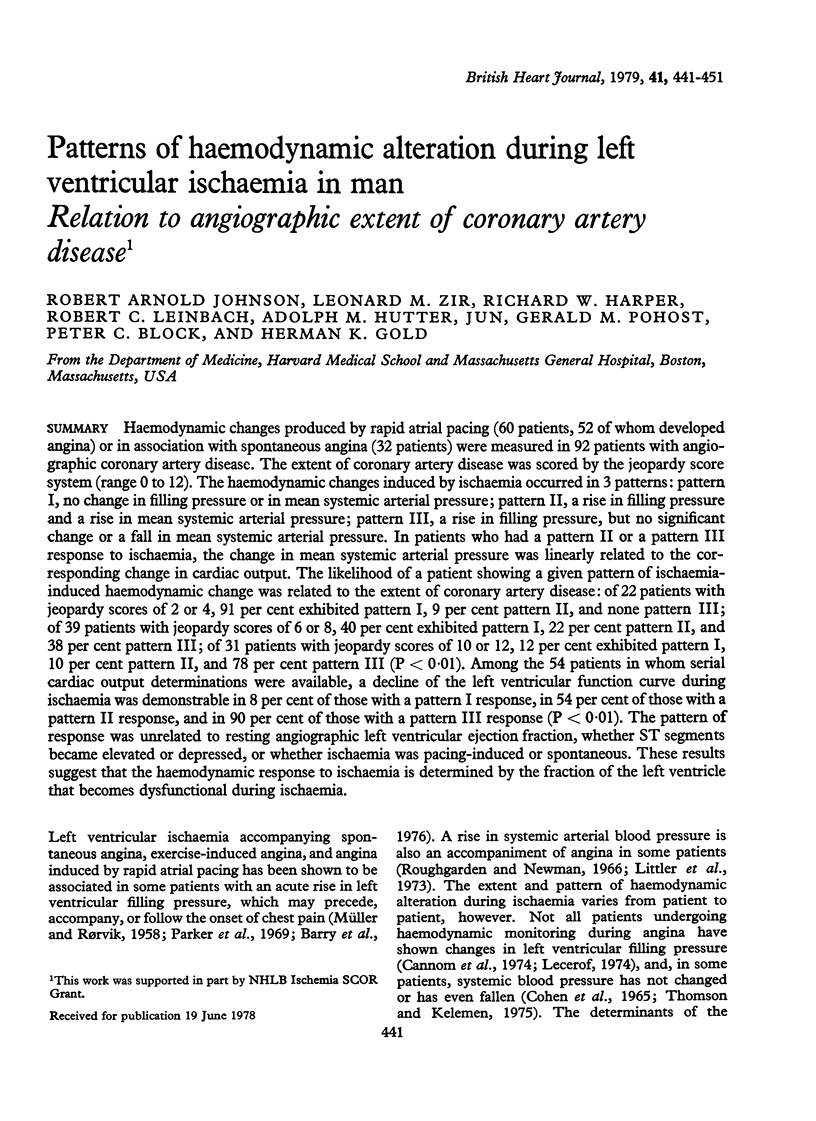
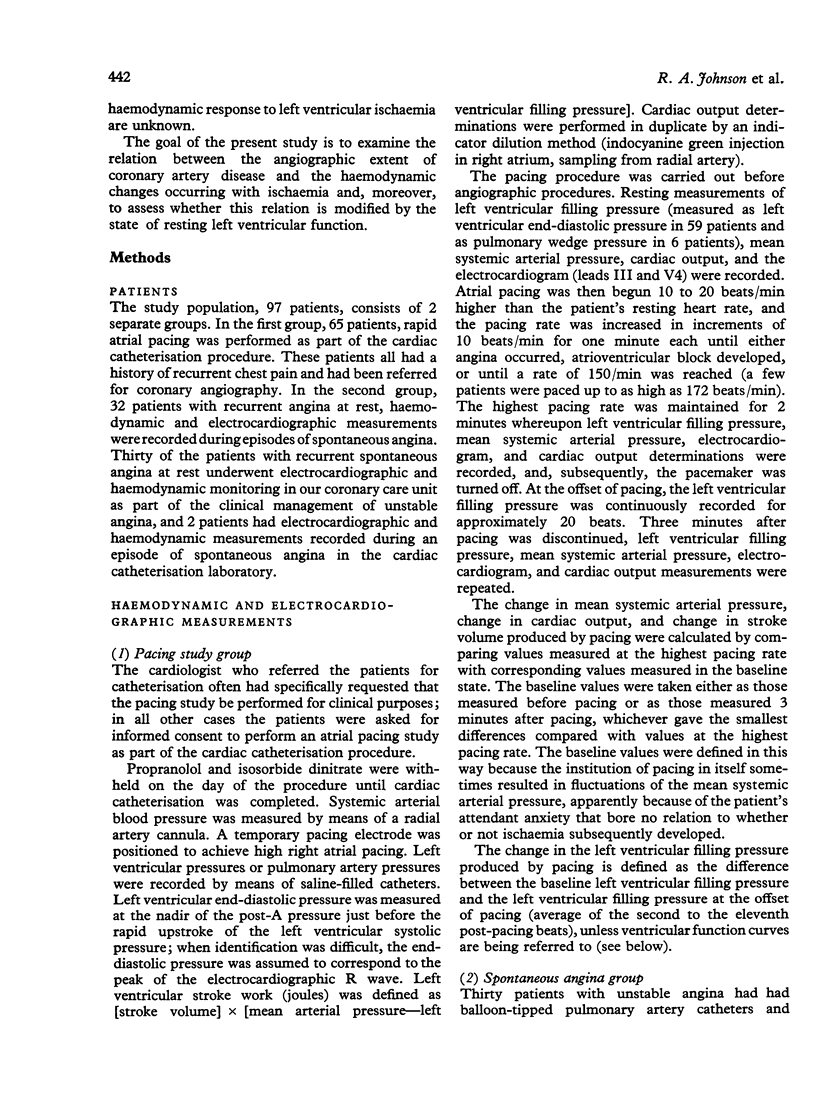
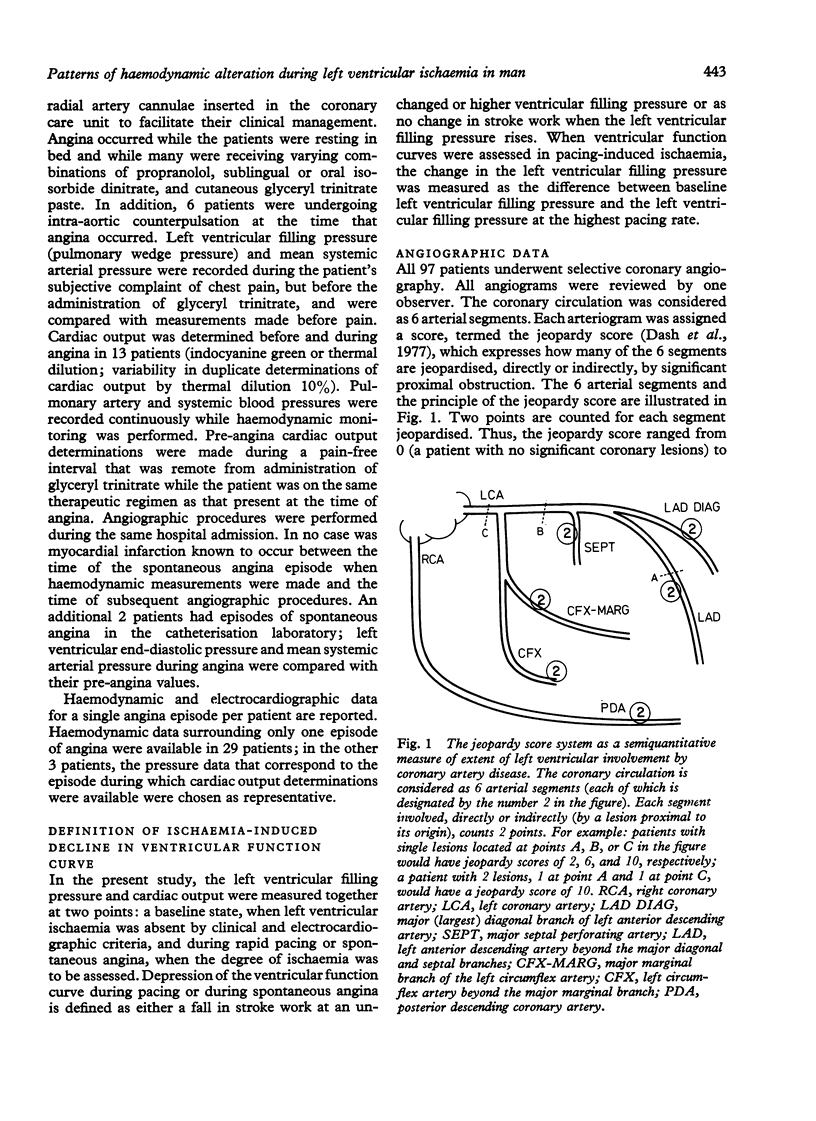
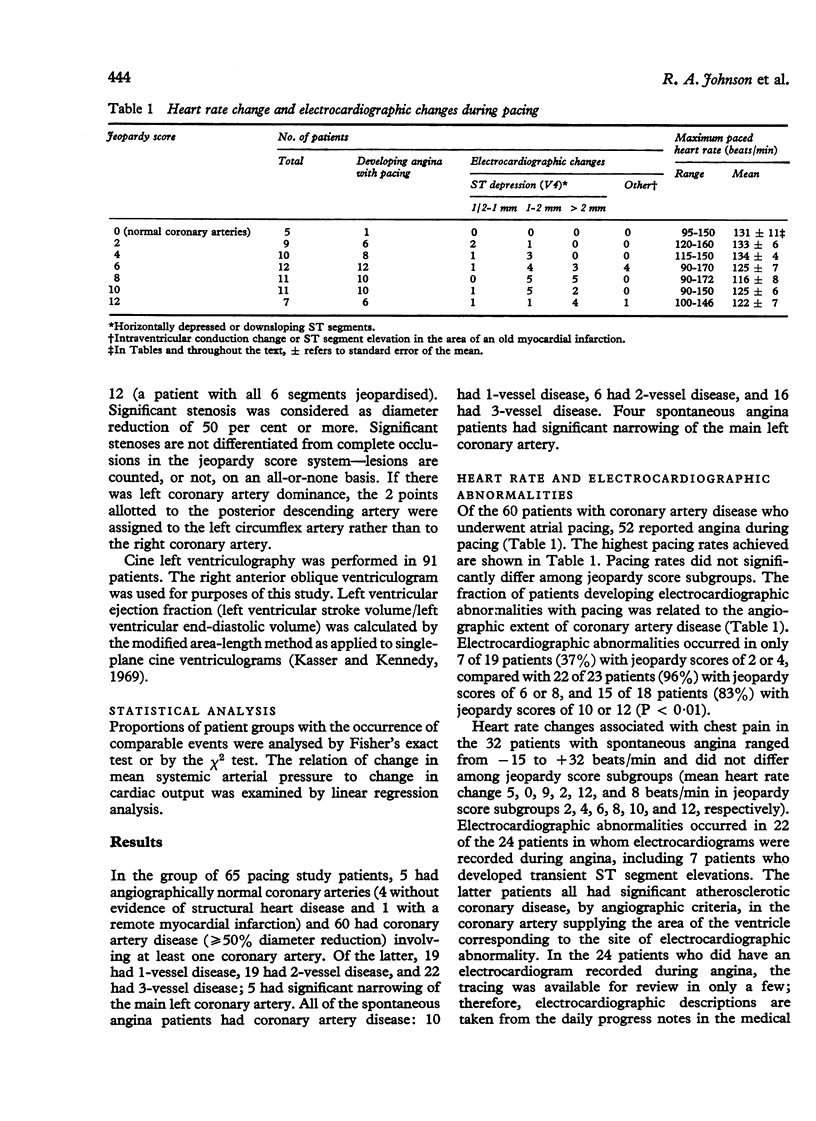
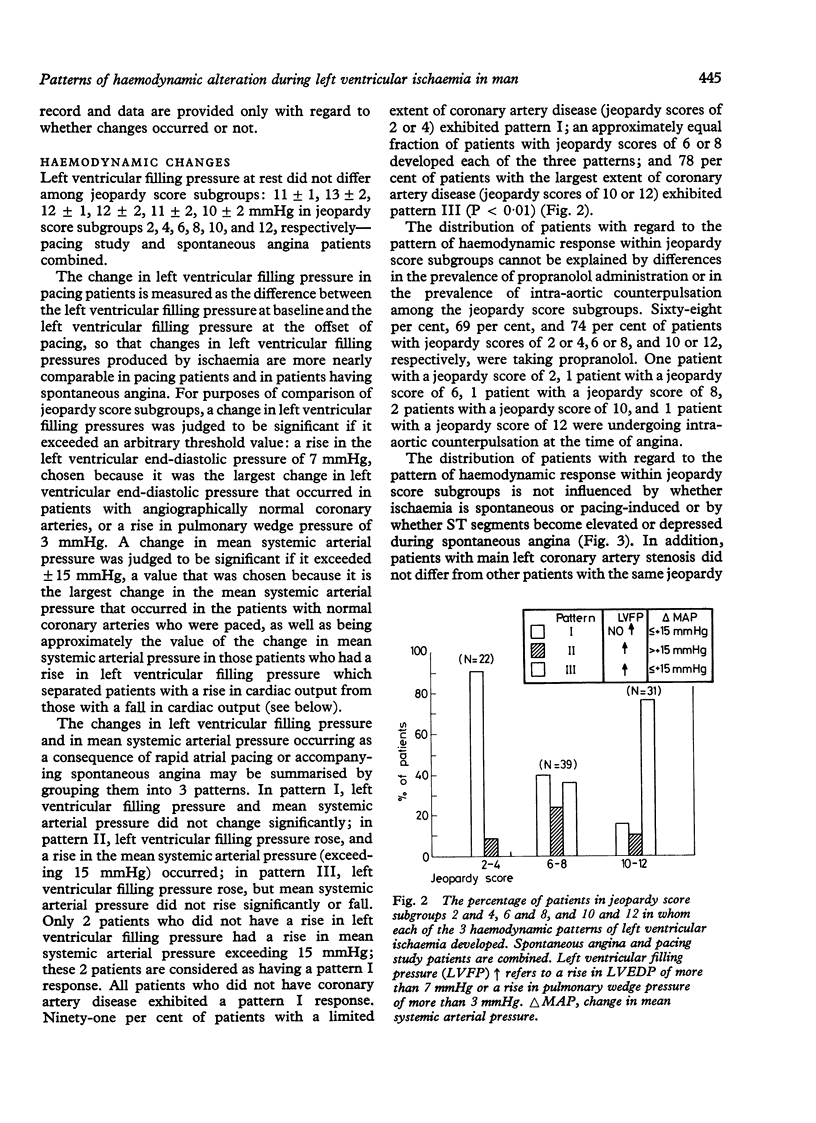
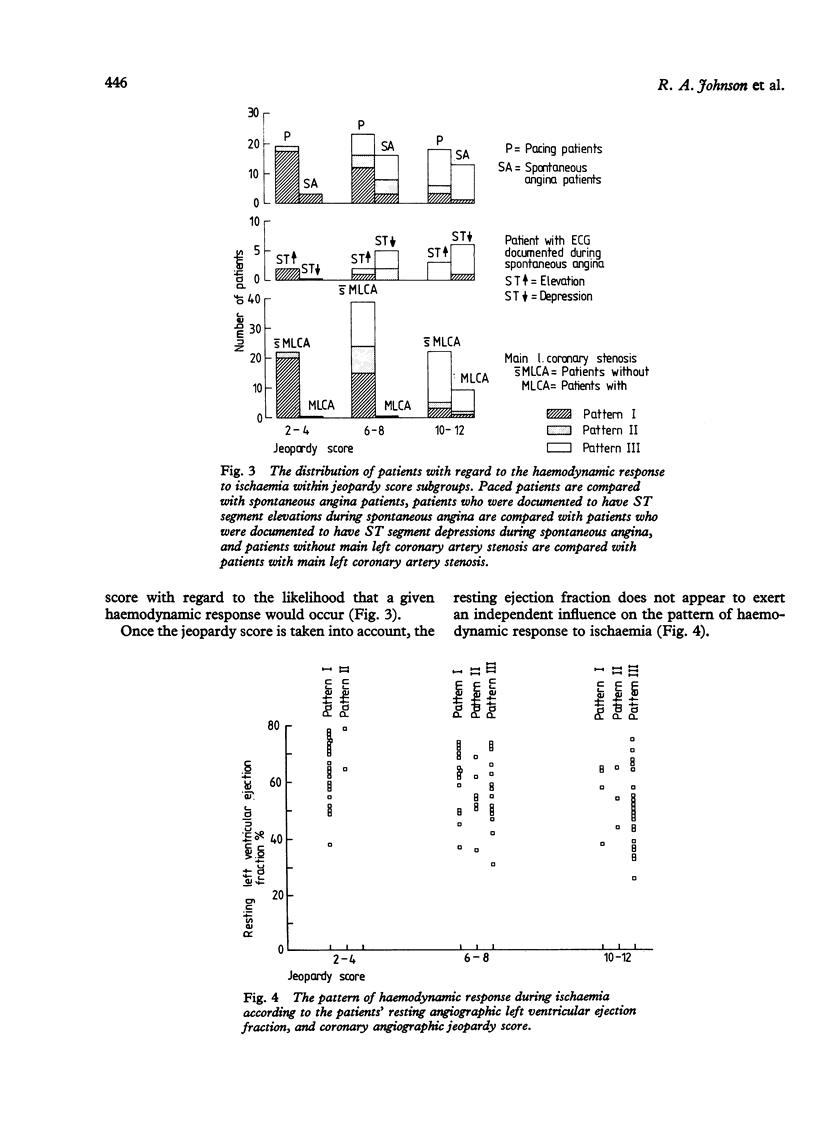
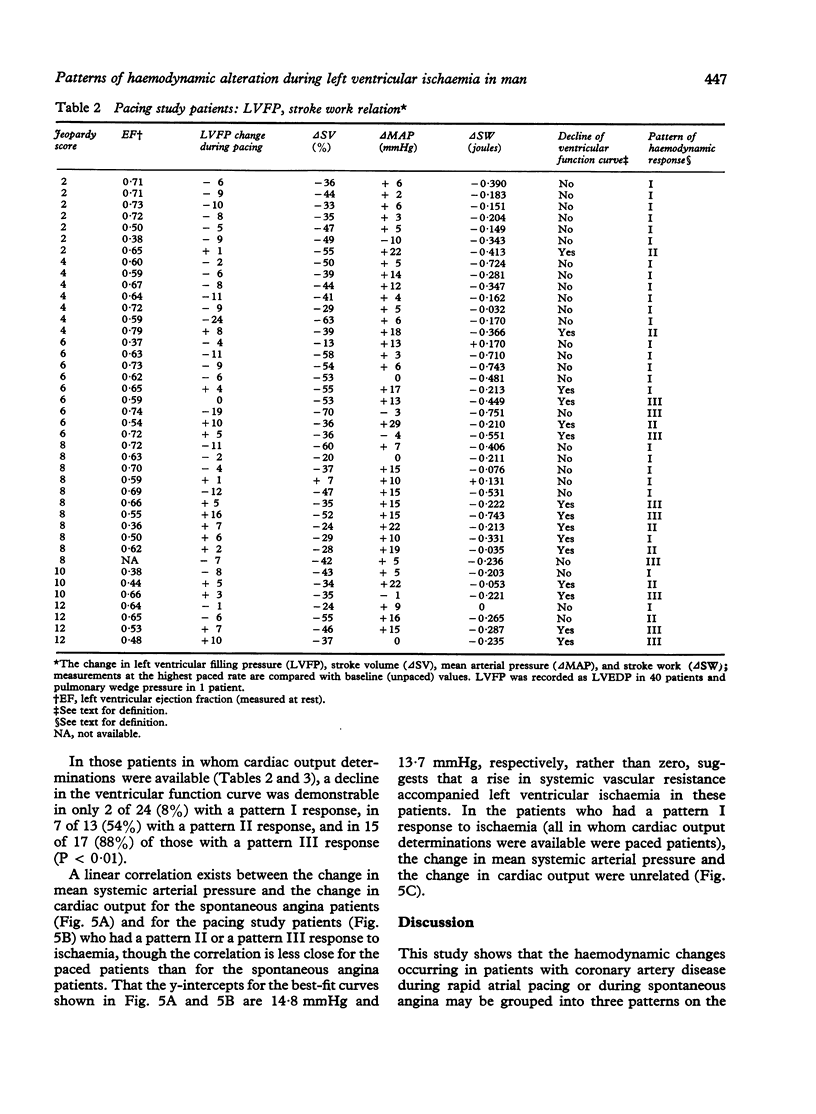
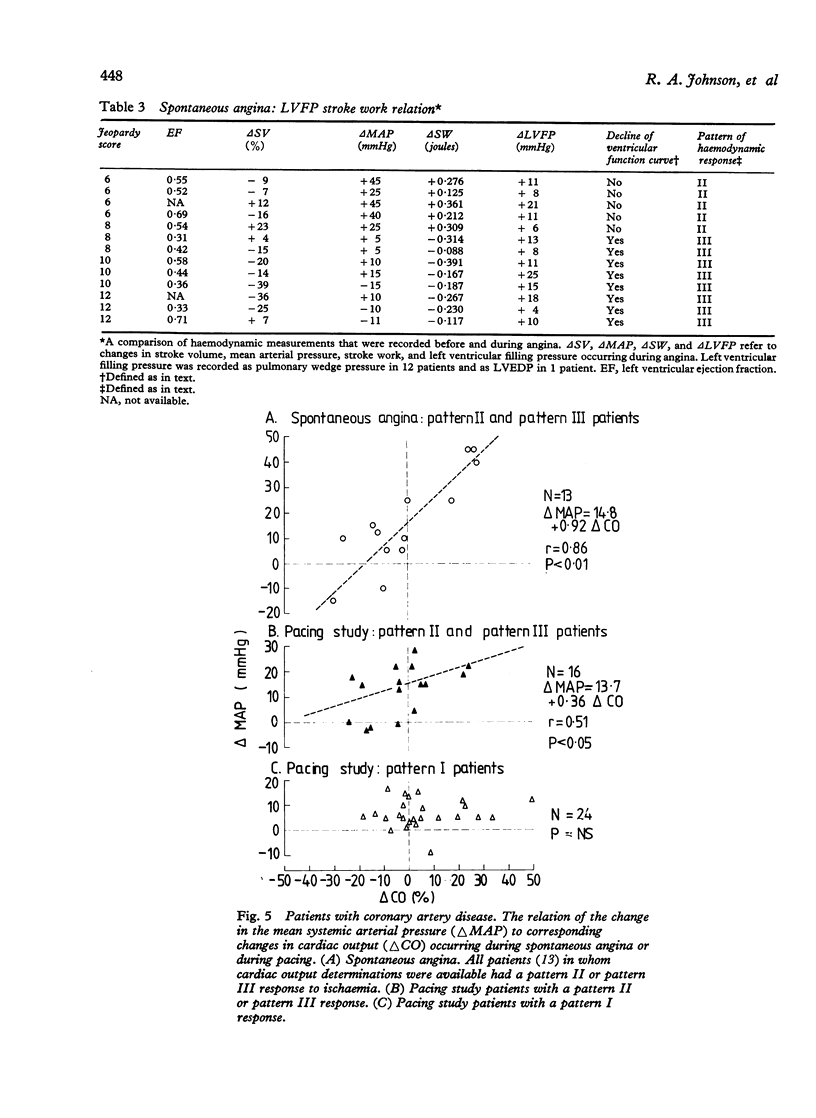
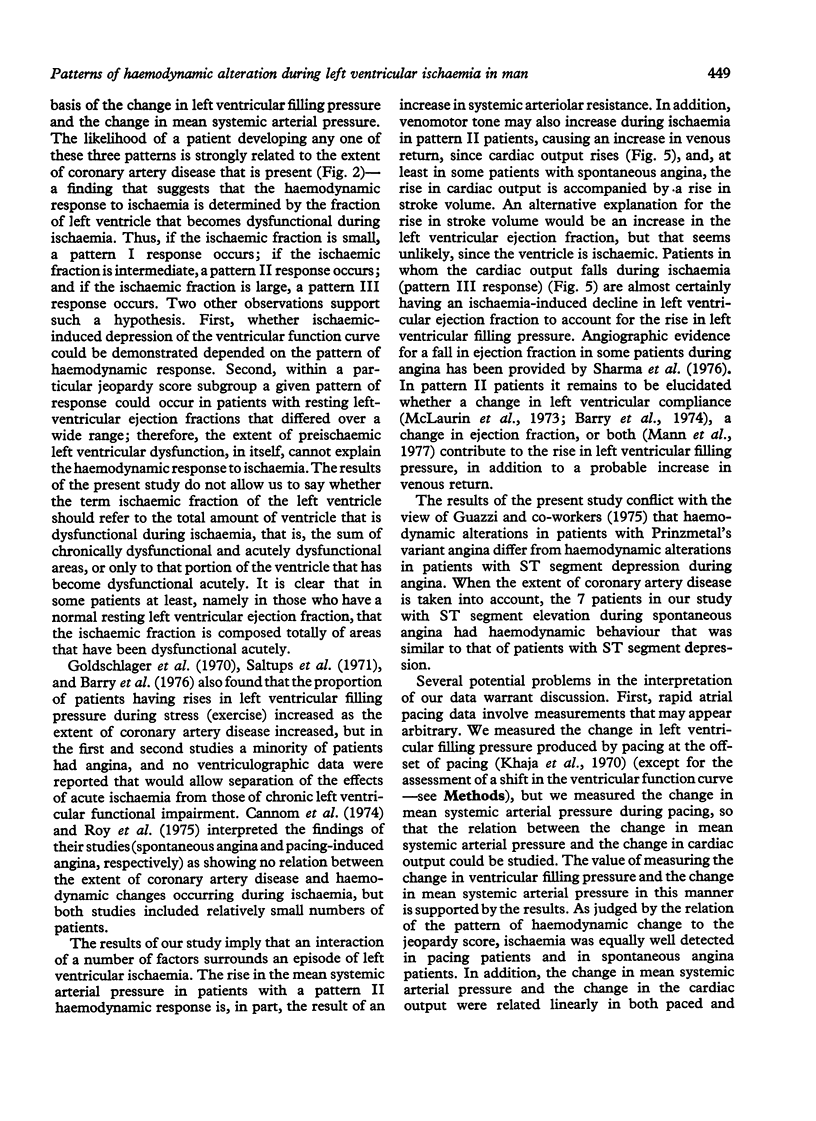
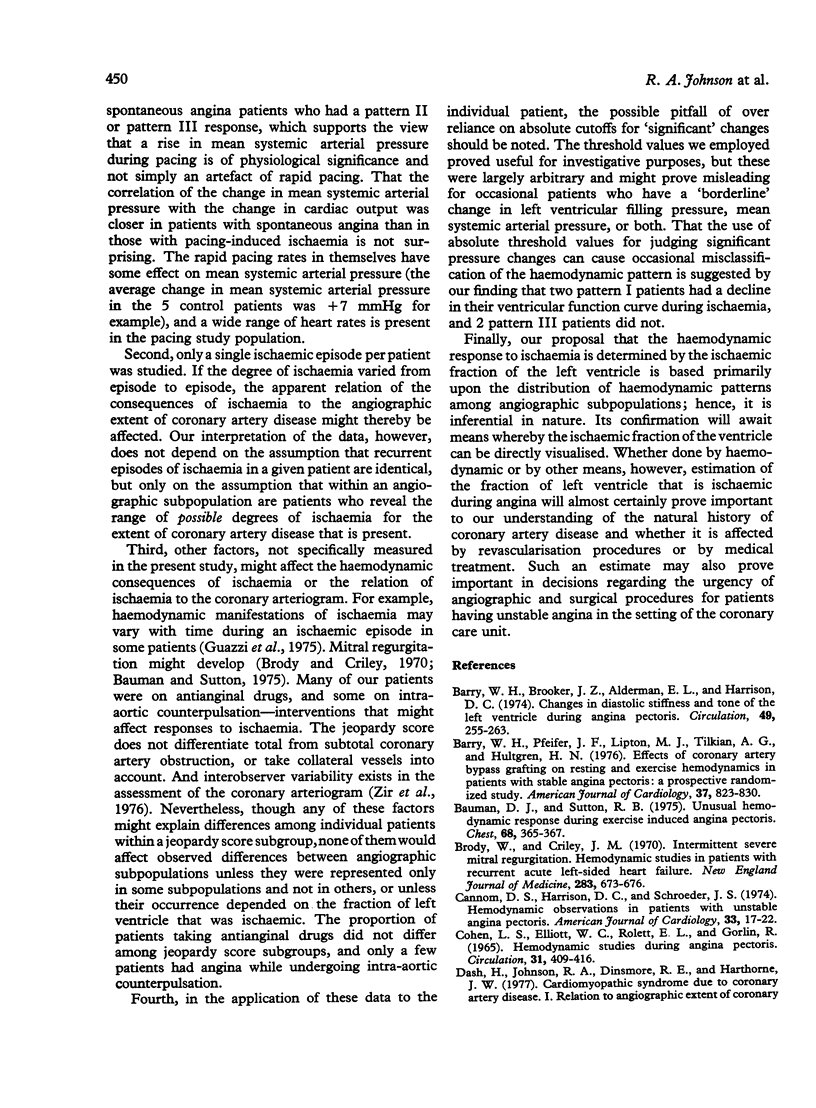
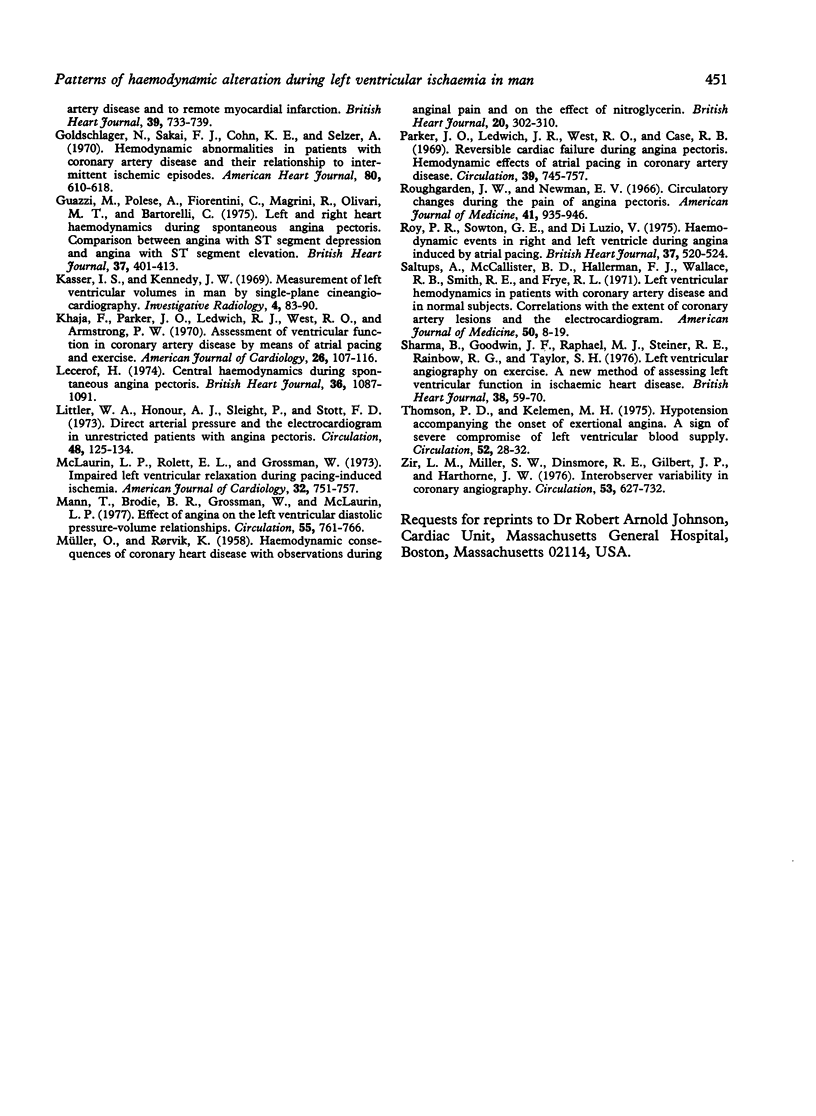
Selected References
These references are in PubMed. This may not be the complete list of references from this article.
- Barry W. H., Brooker J. Z., Alderman E. L., Harrison D. C. Changes in diastolic stiffness and tone of the left ventricle during angina pectoris. Circulation. 1974 Feb;49(2):255–263. doi: 10.1161/01.cir.49.2.255. [DOI] [PubMed] [Google Scholar]
- Barry W. H., Pfeifer J. F., Lipton M. J., Tilkian A. R., Hultgren H. N. Effects of coronary artery bypass grafting on resting and exercise hemodynamics in patients with stable angina pectoris: a prospective, randomized study. Am J Cardiol. 1976 May;37(6):823–830. doi: 10.1016/0002-9149(76)90105-3. [DOI] [PubMed] [Google Scholar]
- Bauman D. J., Sutton R. B. Unusual hemodynamic response during exercise-induced angina pectoris. Chest. 1975 Sep;68(3):365–367. doi: 10.1378/chest.68.3.365. [DOI] [PubMed] [Google Scholar]
- Brody W., Criley J. M. Intermittent severe mitral regurgitation. N Engl J Med. 1970 Sep 24;283(13):673–676. doi: 10.1056/NEJM197009242831303. [DOI] [PubMed] [Google Scholar]
- COHEN L. S., ELLIOTT W. C., ROLETT E. L., GORLIN R. HEMODYNAMIC STUDIES DURING ANGINA PECTORIS. Circulation. 1965 Mar;31:409–416. doi: 10.1161/01.cir.31.3.409. [DOI] [PubMed] [Google Scholar]
- Cannom D. S., Harrison D. C., Schroeder J. S. Hemodynamic observations in patients with unstable angina pectoris. Am J Cardiol. 1974 Jan;33(1):17–22. doi: 10.1016/0002-9149(74)90734-6. [DOI] [PubMed] [Google Scholar]
- Dash H., Johnson R. A., Dinsmore R. E., Harthorne J. W. Cardiomyopathic syndrome due to coronary artery disease. I: Relation to angiographic extent of coronary disease and to remote myocardial infarction. Br Heart J. 1977 Jul;39(7):733–739. doi: 10.1136/hrt.39.7.733. [DOI] [PMC free article] [PubMed] [Google Scholar]
- Goldschlager N., Sakai F. J., Cohn K. E., Selzer A. Hemodynamic abnormalities in patients with coronary artery disease and their relationship to intermittent ischemic episodes. Am Heart J. 1970 Nov;80(5):610–618. doi: 10.1016/0002-8703(70)90007-4. [DOI] [PubMed] [Google Scholar]
- Guazzi M., Polese A., Fiorentini C., Magrini F., Olivari M. T., Bartorelli C. Left and right heart haemodynamics during spontaneous angina pectoris. Comparison between angina with ST segment depression and angina with ST segment elevation. Br Heart J. 1975 Apr;37(4):401–413. doi: 10.1136/hrt.37.4.401. [DOI] [PMC free article] [PubMed] [Google Scholar]
- Kasser I. S., Kennedy J. W. Measurement of left ventricular volumes in man by single-plane cineangiocardiography. Invest Radiol. 1969 Mar-Apr;4(2):83–90. doi: 10.1097/00004424-196904020-00005. [DOI] [PubMed] [Google Scholar]
- Khaja F., Parker J. O., Ledwich R. J., West R. O., Armstrong P. W. Assessment of ventricular function in coronary artery disease by means of atrial pacing and exercise. Am J Cardiol. 1970 Aug;26(2):107–116. doi: 10.1016/0002-9149(70)90767-8. [DOI] [PubMed] [Google Scholar]
- Lecerof H. Central haemodynamics during spontaneous angina pectoris. Br Heart J. 1974 Nov;36(11):1087–1091. doi: 10.1136/hrt.36.11.1087. [DOI] [PMC free article] [PubMed] [Google Scholar]
- Littler W. A., Honour A. J., Sleight P., Stott F. D. Direct arterial pressure and the electrocardiogram in unrestricted patients with angina pectoris. Circulation. 1973 Jul;48(1):125–134. doi: 10.1161/01.cir.48.1.125. [DOI] [PubMed] [Google Scholar]
- MULLER O., RORVIK K. Haemodynamic consequences of coronary heart disease with observations during anginal pain and on the effect of nitroglycerine. Br Heart J. 1958 Jul;20(3):302–310. doi: 10.1136/hrt.20.3.302. [DOI] [PMC free article] [PubMed] [Google Scholar]
- Mann T., Brodie B. R., Grossman W., McLaurin L. P. Effect of angina on the left ventricular diastolic pressure-volume relationship. Circulation. 1977 May;55(5):761–766. doi: 10.1161/01.cir.55.5.761. [DOI] [PubMed] [Google Scholar]
- McLaurin L. P., Rolett E. L., Grossman W. Impaired left ventricular relaxation during pacing-induced ischemia. Am J Cardiol. 1973 Nov;32(6):751–757. doi: 10.1016/s0002-9149(73)80002-5. [DOI] [PubMed] [Google Scholar]
- Parker J. O., Ledwich J. R., West R. O., Case R. B. Reversible cardiac failure during angina pectrois: hemodynamic effects of atrial pacing in coronary artery disease. Circulation. 1969 Jun;39(6):745–757. doi: 10.1161/01.cir.39.6.745. [DOI] [PubMed] [Google Scholar]
- Roughgarden J. W., Newman E. V. Circulatory changes during the pain of angina pectoris. 1772-1965--a critical review. Am J Med. 1966 Dec;41(6):935–946. doi: 10.1016/0002-9343(66)90051-9. [DOI] [PubMed] [Google Scholar]
- Roy P. R., Sowton G. E., Di Luzio V. Haemodynamic events in right and left ventricle during angina induced by atrial pacing. Br Heart J. 1975 May;37(5):520–524. doi: 10.1136/hrt.37.5.520. [DOI] [PMC free article] [PubMed] [Google Scholar]
- Saltups A., McCallister B. D., Hallermann F. J., Wallace R. B., Smith R. E., Frye R. L. Left ventricular hemodynamics in patients with coronary artery disease and in normal subjects. Correlations with the extent of coronary artery lesions and the electrocardiogram. Am J Med. 1971 Jan;50(1):8–19. doi: 10.1016/0002-9343(71)90199-9. [DOI] [PubMed] [Google Scholar]
- Sharma B., Goodwin J. F., Raphael M. J., Steiner R. E., Rainbow R. G., Taylor S. H. Left ventricular angiography on exercise. A new method of assessing left ventricular function in ischaemic heart disease. Br Heart J. 1976 Jan;38(1):59–70. doi: 10.1136/hrt.38.1.59. [DOI] [PMC free article] [PubMed] [Google Scholar]
- Thomson P. D., Kelemen M. H. Hypotension accompanying the onset of exertional angina. A sign of severe compromise of left ventricular blood supply. Circulation. 1975 Jul;52(1):28–32. doi: 10.1161/01.cir.52.1.28. [DOI] [PubMed] [Google Scholar]
- Zir L. M., Miller S. W., Dinsmore R. E., Gilbert J. P., Harthorne J. W. Interobserver variability in coronary angiography. Circulation. 1976 Apr;53(4):627–632. doi: 10.1161/01.cir.53.4.627. [DOI] [PubMed] [Google Scholar]


